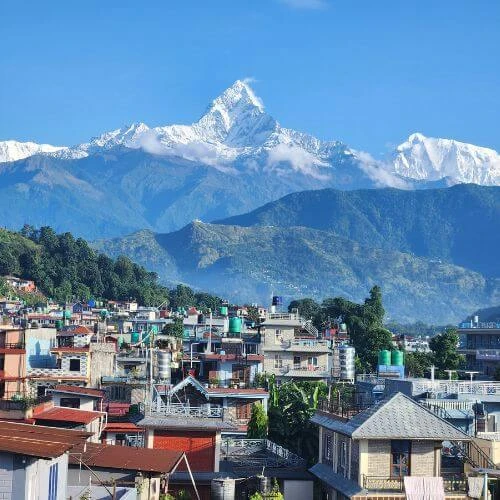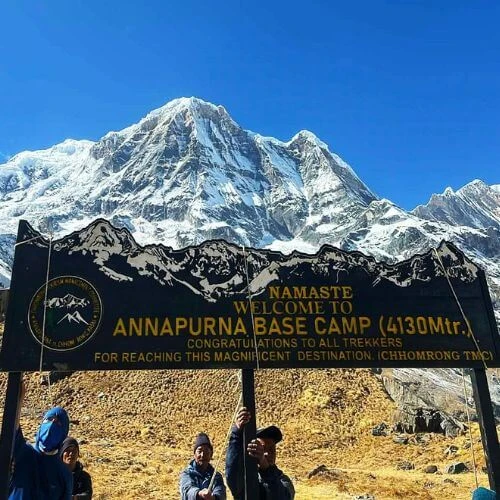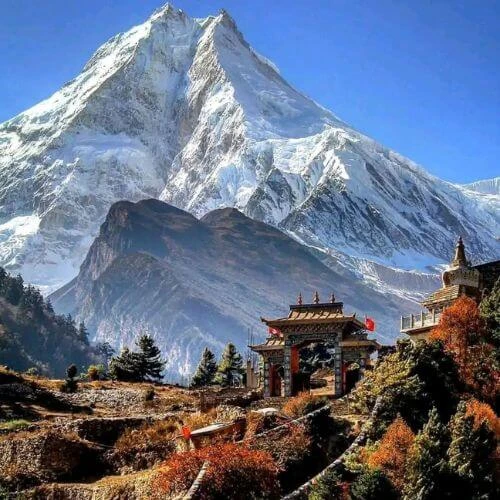Pokhara, known as the city of lakes, is the second-largest city in Nepal and serves as a gateway to major trekking destinations, including the Annapurna, Manaslu, and Dhaulagiri regions. Located in the Annapurna mountain range, approximately 200 kilometers west of Kathmandu, the capital, Pokhara sits at an elevation of around 822 meters on the shores of Phewa Lake. The city is surrounded by towering peaks like Dhaulagiri, Annapurna I, and Manaslu, all reaching over 8,000 meters high, creating a breathtaking Himalayan backdrop. Pokhara offers a unique blend of adventure, tranquility, and culture. The main attraction is Phewa Lake, where visitors can indulge in activities like boating and fishing or simply relax by its peaceful waters reflecting the surrounding mountains. Pokhara also serves as the starting point for the famous Annapurna Circuit trekking trail and is a popular hub for adventure activities such as paragliding, ultralight flights, and zip-lining, making it an ideal destination for those seeking exciting adventures and peaceful moments in the beautiful Himalayan scenery.
Recently, the government declared Pokhara as the tourism capital of Nepal. The city attracts a diverse array of travelers. Adventure enthusiasts flock here to experience the excitement of paragliding, soaring high above the lake and valleys. Others are drawn to trekking, especially the famous Annapurna Circuit Trek, which guides them through stunning landscapes. For those seeking something shorter, there are also easier treks and day hikes to enjoy. Besides trekking, Pokhara offers plenty of other outdoor activities like rock climbing, canyoning, zip-lining, and mountain biking on rugged trails through villages and forests.
Pokhara is not just about adventure; it is a city rich in cultural heritage and monuments. The Hindu and Buddhist cultures blend in their temples, monasteries, and religious festivals. The Bindhyabasini Temple, a key cultural landmark, dedicates itself to the goddess Bhagwati, showcasing its intricate architecture and stone carvings that date back to the 17th century. Additionally, the World Peace Pagoda, a massive Buddhist stupa, embodies peace and solidarity, providing stunning views of the Annapurna range. Visitors can also engage in traditional practices like pottery-making, weaving, and handicraft production in villages around Pokhara, where artisans have preserved these skills through generations. Local markets such as Mahendra Bazar and the lakeside market continue to exhibit age-old trading practices and handicrafts, contributing to the city's cultural richness.

Why is Pokhara considered the Tourism Capital?
On March 17th, 2024, the government of Nepal officially declared Pokhara as the "Tourism Capital" of the country. This prestigious recognition celebrates Pokhara's natural beauty and rich cultural heritage and signifies a commitment to enhancing the visitor experience by ensuring the city remains accessible 24 hours a day.
Pokhara rightfully earns its status as the Tourism Capital, owing to its breathtaking natural beauty, adventure tourism opportunities, and vibrant cultural attractions. Visitors worldwide are captivated by the majestic Annapurna mountain range, serene lakes like Phewa, Begnas, and Rupa, and lush green hills that grace the city. Pokhara serves as a hub for thrilling adventures, including trekking in the Annapurna Conservation Area, paragliding, ultralight flights, zip-lining, and mountain biking. The Lakeside area, particularly around Phewa Lake, offers a vibrant atmosphere with hotels, restaurants, shops, and boating facilities, allowing visitors to immerse themselves in the local culture and lifestyle. Additionally, Pokhara boasts numerous cultural and religious sites, such as the Bindabasini Temple, Gupteshwor Mahadev Cave, Seti Gandaki River, and the World Peace Pagoda, providing insights into the region's rich history and traditions.
To further enhance the visitor experience, Pokhara has committed to ensuring round-the-clock accessibility to the city. This initiative aims to provide tourists with continuous access to essential services, transportation, and amenities, enabling them to fully explore and appreciate the region's natural and cultural wonders at their convenience. With its well-developed tourism infrastructure, including a wide range of accommodation options, tour operators, and travel agencies, Pokhara is poised to deliver an unforgettable experience to travelers seeking adventure, relaxation, and cultural exploration.
Featured Trip: Pokhara City Tour

Things to explore/ do in Pokhara
1. Ariel Activities
Apart from its stunning Himalayan landscapes, Pokhara offers a range of exhilarating aerial activities. Thrill-seekers can go paragliding over the Annapurna range and Phewa Lake from Sarangkot and Pame, take ultralight aircraft flights for open-cockpit views, or experience the adrenaline rush of skydiving against the Himalayan backdrop. For a serene experience, hot air balloon rides at sunrise provide panoramic views of the valley. Helicopter tours are also available to explore the region from above. With favorable weather and experienced operators ensuring safety, Pokhara is a prime destination for aerial adventures.

2. Boating on Phewa Lake
Boating on Phewa Lake in Pokhara offers a great activity. The lake boasts calm waters and beautiful views all around. Visitors can rent different types of boats like rowboats, pedal boats, or motorboats. Rowboats and pedal boats provide a slow, relaxing ride, while motorboats offer a faster pace. Tour companies organize boat tours around the lake, usually lasting 1-2 hours. These tours take people to interesting spots like Barahi Temple on an island in the middle of the lake. Adventure enthusiasts can try kayaking or paddleboarding on the lake, allowing them to explore at their own pace and get close to nature.
Regardless of the chosen boat activity, the views are amazing - with snow-capped Annapurna mountains, green Pokhara valley, and surrounding hills. Phewa Lake is perfect for photography and relaxation. However, boating in Pokhara depends on good weather, and visitors must listen to safety instructions from boat operators.

3. Hike/ Visit to World Peace Pagoda
The World Peace Pagoda in Pokhara is a great destination for those who enjoy hiking and want to learn about Buddhist culture. To get there, you need to walk for about 2 hours up a hill near Phewa Lake. The path goes through green forests, with small Buddhist stupas along the way. You'll see amazing views of the tall Annapurna and Machhapuchhre (fishtail) mountains as you walk.
Upon reaching the hill's summit, you'll encounter the imposing white Peace Pagoda structure. This pagoda holds significant importance for peace and non-violence. The surroundings exude tranquility, offering serene vistas of the lake and mountains. It's an ideal spot to sit quietly, meditate, and absorb the spiritual atmosphere.
Visitors can explore the area around the pagoda, spin the prayer wheels, and experience the unique energy of this sacred Buddhist site. It provides a peaceful setting to reconnect with nature and delve into the teachings of Buddha.

4. Explore caves
Some cool caves in Pokhara are fun to explore. One popular cave is the Mahendra Gufa. To reach it, you walk through a tunnel into the side of a hill. Inside the cave, you'll find big open spaces and smaller tunnels to crawl through. The cave feels mysterious with dim lighting and different paths to follow. You might see some bats hanging from the ceiling! Another cave called Bat Cave houses thousands of bats. When you shine a light inside, you can see them all clinging to the walls and flying around. Exploring these dark, echoey caves is an adventure. Just make sure to bring a flashlight and watch your step on the uneven floors. The caves offer a nice break from being outside in the hot sun. But be cautious not to go too far in, as some areas are off-limits.
5. View Sunrise at Sarangkot
Experiencing the magical sunrise from Sarangkot is a must in Pokhara. Sarangkot is a hilltop with a stunning view of the Annapurna mountain range. To reach there, you can either drive or hike up the hill in the early dark morning. At the top, you'll find hotels and viewpoints facing the mountains. As the sun rises, the sky transforms into beautiful shades of orange, pink, and purple. Gradually, the first rays of sunlight illuminate the snowy peaks of the massive Annapurna mountains, rendering them a brilliant white glow. The breathtaking sight of the mountains emerging from the darkness will mesmerize you. You can enjoy a hot cup of tea or coffee while witnessing this natural spectacle. Experiencing the sunrise over the Himalayas from Sarangkot offers a peaceful and unforgettable start to your day in Pokhara.

6. Mountain Biking
Mountain biking offers a cool way to explore the beautiful nature around Pokhara. There are many trails of different difficulty levels suitable for both beginners and experienced bikers. Some easy routes follow the Phewa Lake shoreline or pass through local villages, offering great mountain views. More advanced trails meander up and down the hills and forests outside of town. The trails can become bumpy, muddy, and steep in parts, which adds to the excitement! Guides often lead mountain biking tours to ensure you don't lose your way on the paths. Riding a bike allows you to cover more ground than hiking while still being close to the outdoors. Along the way, you may even spot monkeys or other wildlife! Just make sure to wear a helmet and bring water and snacks for energy. With amazing scenery of lakes, rivers, and Himalayan peaks in the distance, mountain biking lets you experience Pokhara's landscapes in an adventurous way.
7. Relax and Rejuvenate
Pokhara offers the perfect setting to take a break and recharge your mind and body. The peaceful lake views and fresh mountain air create a calming atmosphere. You can kickstart your day with a relaxing yoga or meditation session while watching the sunrise over the Annapurna peaks. Spend lazy afternoons reading a book or napping in a lakeside café, with the sound of water lapping at the shores. Treat yourself to a massage or spa therapy using traditional Nepali techniques and herbal products to soothe sore muscles after hiking or trekking. Make sure to indulge in delicious Nepali cuisine like momos and dal bhat. In the evenings, take a stroll along the lakeside and browse handicraft stalls. The lack of crowds and pollution allows you to unwind and connect with nature's tranquility in Pokhara simply. Return home feeling refreshed, rejuvenated, and renewed after this laidback mountain town escape.

8. Go Trekking
Pokhara offers a great starting point for awesome trekking adventures in the Himalayas. From the city, you can embark on short day hikes or multi-day treks into the mountains. Some popular trekking routes start just outside of Pokhara and lead you through villages, and forests, and up to viewpoints with incredible panoramas of the giant Annapurna peaks. Longer treks may require camping overnight under the stars. The trails might present steep and challenging sections at times, but the amazing mountain scenery makes the effort worthwhile. Trekking enables you to truly experience Nepal's nature up close - you can see rhododendron flowers, cross suspension bridges over rivers, and perhaps even spot some wildlife! Be sure to pack sturdy hiking shoes, warm layers, and snacks. It's recommended to hire an experienced local trekking guide, especially for longer routes, as they are familiar with the terrain and can share interesting facts about the mountains and cultures you encounter. Trekking from Pokhara allows you to immerse yourself in Nepal's outdoor paradise.
Best time to visit Pokhara
Pokhara is a great place to visit throughout the year, but the best time to go is from September to November, which is considered the peak season. During this time, temperatures in Pokhara can reach up to 22 degrees Celsius during the day and drop to around 12 degrees Celsius at night. In June, July, and August, it's the monsoon season in Nepal, so many people avoid traveling then. However, some enjoy the clearer sunrise after the rain. December, January, and February are the winter months, but Pokhara's winters are mild, although the surrounding mountains can bring cooler air. Mornings can be foggy during this time, potentially affecting views of the sunrise from Sarangkot. The summer season sees temperatures in Pokhara rising to as high as 31°C, making it less favorable for visits. Nevertheless, it's the peak tourist season, offering ample opportunities for sightseeing and enjoying the city.

How to reach Pokhara
You can reach Pokhara from Kathmandu, Nepal's capital city, through three main ways:
- By air: This option is the quickest and most convenient, especially if you're short on time. Several airlines operate daily flights between Kathmandu's Tribhuvan International Airport and Pokhara International Airport. The flight typically takes around 30-40 minutes, offering breathtaking views of the Himalayas on clear days. Prices may vary depending on the airline, time of year, and demand, but generally range from $40 to USD 120 per person for a one-way ticket.

- By road: To get to Pokhara from Kathmandu on a budget, consider taking a bus. The journey can take anywhere from 6 to 12 hours, depending on the type of bus ( Public or tourist ) and road conditions. Public buses are the cheapest option, costing around USD 4 for a one-way ticket. However, they can be crowded and lack amenities. On the other hand, tourist buses offer a more comfortable ride with air conditioning and reclining seats, but they cost around 15-18 USD for a one-way trip. Buses depart from various stations in Kathmandu, with the Gongabu Bus Park being a common starting point.
- By private vehicle: Renting a car or hiring a private taxi is another way to get to Pokhara, giving you the flexibility to stop where you want. But remember, Nepal's roads can be tricky, so having a skilled driver who knows the mountains is important. This option isn't as common because the journey can be long and traffic can slow things down. It's good for small groups or if you have specific needs. The trip usually takes 6-8 hours, but that can change depending on how busy the roads are. You can negotiate the price with taxi companies or private drivers, and the cost depends on factors such as the type of vehicle and the number of people traveling.
Transportation within Pokhara
In Pokhara, you have plenty of ways to get around and see all the beautiful sights. You can take a taxi, hop on a local bus, or enjoy the excitement of riding in an auto-rickshaw. If you prefer a slower pace, you can even cycle around. The city is easy to navigate, especially in the downtown area and along the lakeside in Pokhara, where you can walk around and immerse yourself in the stunning scenery and vibrant culture. Here are some transportation options to get around the Pokhara Valley.
- Local Buses: In Pokhara, there are local buses that go all around the city. They are economical and lots of people use them. But sometimes they get crowded, especially at busy times. And the schedules might only sometimes be followed exactly.
- Rent Private Vehicles: Several private companies run tourist buses that give sightseeing tours around Pokhara and its surrounding areas. Tourists prefer them because they're comfortable and have air conditioning.
- Renting a bike or a scooter: Renting a scooter or bike is a popular choice for getting around Pokhara, especially for those who want to explore at their own pace. Rental shops across the city easily provide scooters, with prices typically ranging from NPR 500 to NPR 1,000 per day, depending on the scooter's condition and rental location. You'll need a valid driver's license to rent one, and some places might require a refundable security deposit. Scooters are great for navigating Pokhara's narrow streets and visiting nearby attractions like the Peace Pagoda and Begnas Lake. Just be careful, as traffic can be hectic, especially for new riders.
- Rickshaws: For short distances and exploring the city at a leisurely pace, consider bicycles and cycle rickshaws as excellent options. Many hotels and guesthouses in Pokhara provide bicycle rentals, and you can find cycle rickshaws around tourist areas.

Conclusion
Pokhara truly deserves its status as the Tourism Capital of Nepal. With its awe-inspiring natural scenery, abundant adventure opportunities, rich cultural heritage, and well-developed tourism infrastructure, Pokhara offers an unparalleled experience for visitors from around the world. Whether you seek the thrill of aerial adventures, the serenity of trekking through the Himalayas, the tranquility of boating on Phewa Lake, or the opportunity to immerse yourself in local traditions, Pokhara has something for everyone. Its commitment to ensuring 24-hour accessibility further enhances the visitor experience, making it an ideal destination for travelers seeking adventure, relaxation, and cultural exploration in the heart of the Annapurna region. The recognition of Pokhara as the Tourism Capital highlights its lasting charm and the hospitable nature of its residents encouraging visitors to create unforgettable experiences in this stunning region of Nepal.














